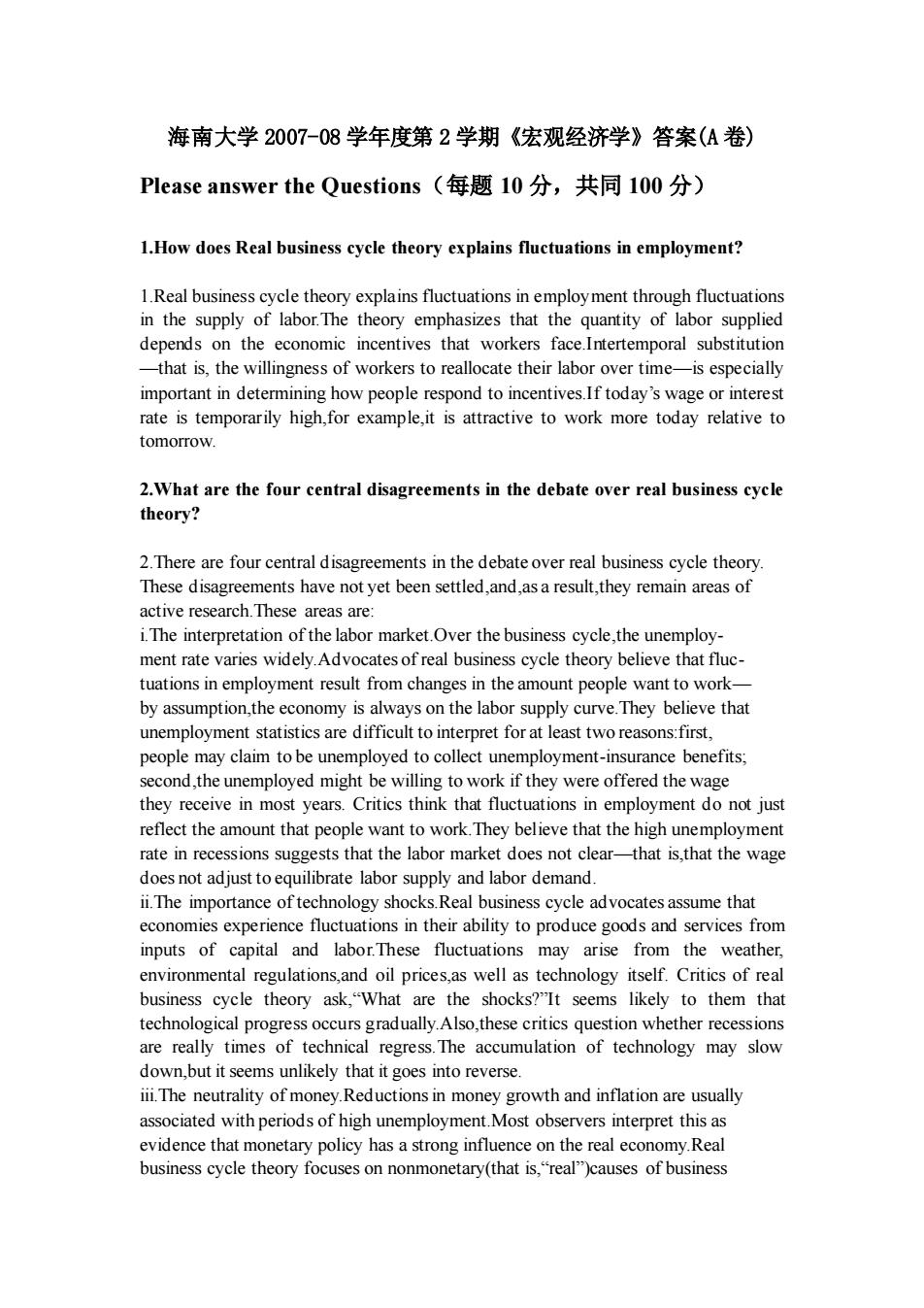正在加载图片...

海南大学2007-08学年度第2学期《宏观经济学》答案(A卷) Please answer the Questions(每题10分,共同100分) 1.How does Real business cycle theory explains fluctuations in employment? 1.Real business cycle theory explains fluctuations in employ ment through fluctuations in the supply of labor.The theory emphasizes that the quantity of labor supplied depends on the economic incentives that workers face.Intertemporal substitution -that is,the willingness of workers to reallocate their labor over time-is especially rate is temporarily high,for example,it is attractive to work more today relative to tomorrow. 2.What are the four central disagreements in the debate over real business cycle theory? 2.There are four central disagreements in the debate over real business cycle theory These disagreements have not yet been settled,and,as a result,they remain areas of active research.These areas are: i.The interpretation of the labor market.Over the business cycle.the unemploy- widelyAdvoc busines ycl theory believe tuations in employment result from changes in the amount people want to work- by assumption,the economy is always on the labor supply curve.They believe that unemployment statistics are difficult to interpret for at least two reasons:first, people may claim to be unemployed to collect unemployment-insurance benefits; willing to work if they were offered the wage they receive in most years.Critics think tions nmployment on just reflect the amount that people want to work.They believe that the high unemployment rate in recessions suggests that the labor market does not clear-that is,that the wage does not adjust to equilibrate labor supply and labor demand. ii.The importance oftechnology shocks.Real business cycle advocates assume that expe nce fluctua in their ability to produce oods and services from e weather environmental regulations,and oil prices,as well as technology itself.Critics of real business cycle theory ask,"What are the shocks?"It seems likely to them that techlgical progress occurs gradually.Also,these critics question whether of techn ess.The accumulation eems unlikely thatitgonever egre iii.The neutrality of money.Reductions in money growth and inflation are usually associated with periods of high unemployment.Most observers interpret this as evidence that monetary policy has a strong influence on the real economy.Real business cycle theory focuses on nonmonetary(that is,"real"causes of business海南大学 2007-08 学年度第 2 学期《宏观经济学》答案(A 卷) Please answer the Questions(每题 10 分,共同 100 分) 1.How does Real business cycle theory explains fluctuations in employment? 1.Real business cycle theory explains fluctuations in employment through fluctuations in the supply of labor.The theory emphasizes that the quantity of labor supplied depends on the economic incentives that workers face.Intertemporal substitution —that is, the willingness of workers to reallocate their labor over time—is especially important in determining how people respond to incentives.If today’s wage or interest rate is temporarily high,for example,it is attractive to work more today relative to tomorrow. 2.What are the four central disagreements in the debate over real business cycle theory? 2.There are four central disagreements in the debate over real business cycle theory. These disagreements have not yet been settled,and,as a result,they remain areas of active research.These areas are: i.The interpretation of the labor market.Over the business cycle,the unemployment rate varies widely.Advocates of real business cycle theory believe that fluctuations in employment result from changes in the amount people want to work— by assumption,the economy is always on the labor supply curve.They believe that unemployment statistics are difficult to interpret for at least two reasons:first, people may claim to be unemployed to collect unemployment-insurance benefits; second,the unemployed might be willing to work if they were offered the wage they receive in most years. Critics think that fluctuations in employment do not just reflect the amount that people want to work.They believe that the high unemployment rate in recessions suggests that the labor market does not clear—that is,that the wage does not adjust to equilibrate labor supply and labor demand. ii.The importance of technology shocks.Real business cycle advocates assume that economies experience fluctuations in their ability to produce goods and services from inputs of capital and labor.These fluctuations may arise from the weather, environmental regulations,and oil prices,as well as technology itself. Critics of real business cycle theory ask,“What are the shocks?”It seems likely to them that technological progress occurs gradually.Also,these critics question whether recessions are really times of technical regress.The accumulation of technology may slow down,but it seems unlikely that it goes into reverse. iii.The neutrality of money.Reductions in money growth and inflation are usually associated with periods of high unemployment.Most observers interpret this as evidence that monetary policy has a strong influence on the real economy.Real business cycle theory focuses on nonmonetary(that is,“real”)causes of business